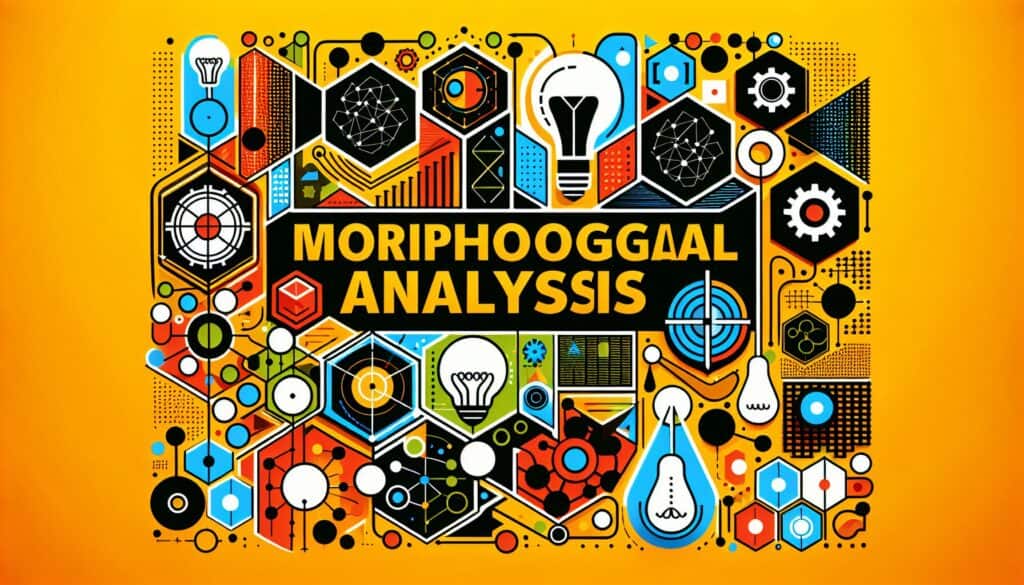Una tecnica di risoluzione dei problemi e di ideazione che prevede la scomposizione di un problema o di un sistema complesso nei suoi parametri o dimensioni fondamentali, per poi generare tutte le possibili combinazioni di questi per trovare nuove soluzioni.
- Metodologie: Clienti e marketing, Ideazione, Progettazione del prodotto
Analisi morfologica

Analisi morfologica
- Creatività, Progettazione per la produzione additiva (DfAM), Ottimizzazione del design, Pensiero progettuale, Ideazione, Innovazione, Tecniche di risoluzione dei problemi, Linguaggio di modellazione dei sistemi (SysML), Ingegneria del valore (VE)
Obiettivo:
Come si usa:
- Identifica le caratteristiche o le funzioni chiave di un prodotto/problema. Per ogni caratteristica, viene generato un elenco di possibili varianti o implementazioni. Le combinazioni di queste varianti vengono poi esplorate sistematicamente.
Professionisti
- Fornisce un modo sistematico per esplorare un'ampia gamma di potenziali soluzioni o configurazioni; può portare a idee innovative e inaspettate; aiuta a garantire che tutte le possibilità siano considerate.
Contro
- Può diventare molto complesso e generare un numero eccessivo di combinazioni se ci sono molti parametri o variazioni; valutare tutte le combinazioni può essere poco pratico; richiede una chiara definizione dei parametri.
Categorie:
- Ideazione, Risoluzione dei problemi, Progettazione del prodotto
Ideale per:
- Strutturare ed esplorare sistematicamente tutte le possibili soluzioni a un problema complesso, scomponendolo nelle sue dimensioni principali e generando combinazioni.
L'analisi morfologica è spesso utilizzata in settori quali la progettazione automobilistica, l'ingegneria aerospaziale e l'elettronica di consumo, dove le complessità delle caratteristiche e delle funzioni dei prodotti richiedono un esame approfondito. Durante la fase concettuale dei progetti, i team composti da ingegneri, designer e product manager utilizzano questa metodologia per analizzare la natura sfaccettata delle sfide che devono affrontare. Identificando le caratteristiche fondamentali di un prodotto o di un problema, come le dimensioni, il materiale o la funzionalità, e generando variazioni per ciascuna di esse, i team possono esplorare una vasta gamma di combinazioni che potrebbero portare a soluzioni innovative. Per esempio, nel design automobilistico, le variazioni possono includere diversi tipi di sistemi di propulsione (elettrici, ibridi, a combustione tradizionale) combinati con vari stili di carrozzeria (berlina, SUV, coupé), che possono dare origine a numerosi concetti di veicoli innovativi. Questa esplorazione strutturata favorisce la creatività, facilitando l'emergere di soluzioni precedentemente non considerate che migliorano l'attrattiva del prodotto e rispondono alle esigenze degli utenti o alle preoccupazioni ambientali. I workshop e le sessioni di collaborazione sono spesso organizzati intorno a questa metodologia, consentendo input diversi e cooperazione interdisciplinare, che non solo amplia il processo di esplorazione, ma allinea anche l'attenzione del team su risultati realizzabili e coerenti.
Fasi chiave di questa metodologia
- Identificare le dimensioni fondamentali del problema o del prodotto.
- Definire le caratteristiche o le funzioni chiave relative a ciascuna dimensione.
- Generare un elenco completo di possibili varianti per ogni caratteristica.
- Creare una matrice morfologica per combinare le variazioni in modo sistematico.
- Esplorare diverse configurazioni analizzando la matrice.
- Selezionare e valutare le combinazioni promettenti in termini di fattibilità e rilevanza.
- Affinare le configurazioni in base al feedback e alle intuizioni acquisite.
- Documentare le combinazioni selezionate per un ulteriore sviluppo e prototipazione.
Suggerimenti per i professionisti
- Utilizzare le tecniche di clustering durante la fase di generazione delle variazioni per identificare le sinergie tra le caratteristiche, consentendo combinazioni più forti che potrebbero non essere immediatamente evidenti.
- Integrare i cicli di feedback delle parti interessate nelle varie fasi dell'analisi per convalidare e perfezionare le combinazioni, garantendo la pertinenza e l'applicabilità agli scenari del mondo reale.
- Utilizzare strumenti di simulazione per visualizzare e testare la fattibilità delle combinazioni selezionate, consentendo iterazioni e aggiustamenti più rapidi prima di passare ai prototipi fisici.
Leggere e confrontare diverse metodologie, raccomandiamo il
> Ampio archivio di metodologie <
insieme ad altre 400 metodologie.
I vostri commenti su questa metodologia o ulteriori informazioni sono benvenuti su sezione commenti qui sotto ↓ , così come tutte le idee o i link relativi all'ingegneria.
Contesto storico
1949
1950
1950
1960
1960
1960
1960
1940
1950
1950
1958
1960
1960
1960
1960
(se la data non è nota o non è rilevante, ad esempio "meccanica dei fluidi", viene fornita una stima approssimativa della sua notevole comparsa)















Post correlati
Questionari sul disagio muscoloscheletrico
Test multivariati (MVT)
Analisi di regressione multipla
Sistemi di cattura del movimento
Metodo MoSCoW
Test mediano dell'umore